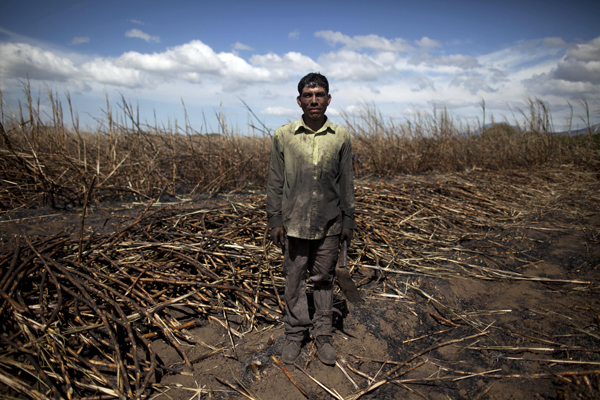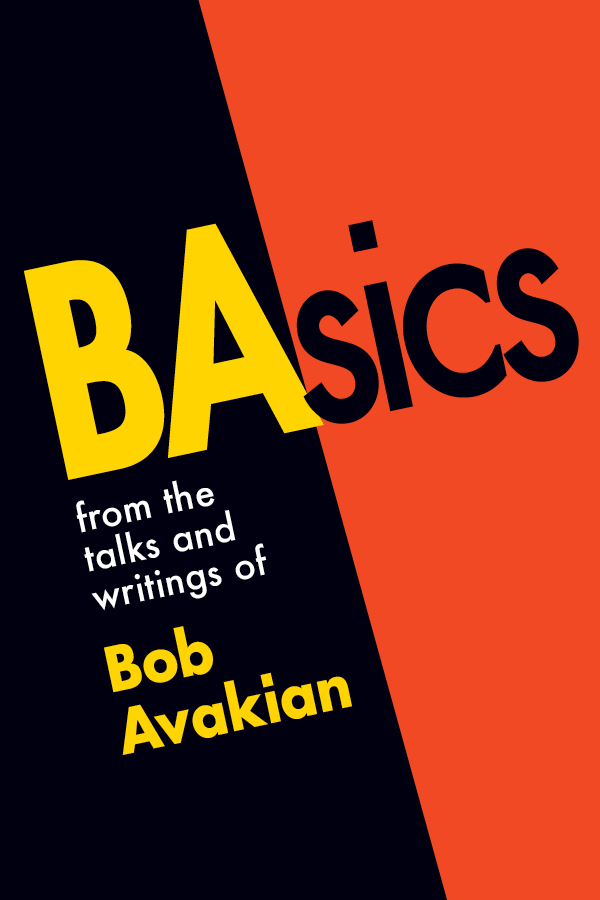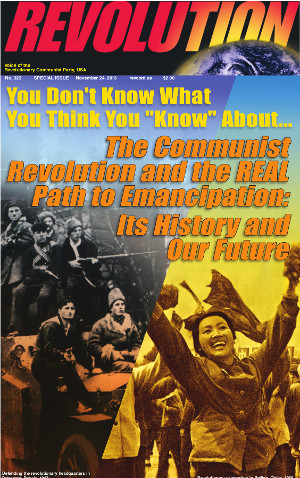From A World to Win News Service:
Nicaragua: Sugar is poison
May 18, 2015 | Revolution Newspaper | revcom.us

Cane cutter poses for a portrait in the fields where he works. In the past two decades, at least 20,000 workers lost their lives to a chronic kidney disease attributed to working conditions on sugar cane plantations in Central America. (AP Photo/Esteban Felix)
11 May 2015. A World to Win News Service. "Sugar is poison." This is a warning we frequently find in the media these days, about the dangers of consuming sugar. But sugar is a "poison" even for those who produce it.
In the past two decades, at least 20,000 workers lost their lives because of working conditions on sugar cane plantations in Central America. They all suffered from a chronic kidney disease called CKDnT. According to La Isla Foundation, from 2002-2012 in Chichigalpa, a vast area of sugar cane plantations in northwest Nicaragua, about 75 percent of the deaths of men aged 35-55 were caused by CKDnT. Nearly every family has lost a member to this epidemic.
This unusual kidney disease is not due to common factors such as hypertension and diabetes. While most studies (for example, by Boston University and the School of Public Health) show a clear correlation between the disease and the work these men are doing, big companies like Ingenio San Antonio (ISA), Nicaragua’s oldest and biggest sugar mill, do not accept that there is a connection between CKDnT and working conditions on its plantations. As the Guardian revealed in its 16 February report, these companies "are supporting research into possible non-occupational causes – recently donating £430,000 for research into genetic and childhood links to CKDnT."
The U.S. Occupational Safety and Health Administration recommends 45 minutes of rest after 15 minutes of heavy work in conditions of extreme heat, to keep the body from overheating. During the harvest months, ISA's field hands work for eight to 14 hours in 38 C [100 F] temperatures. They work six or seven days a week, cutting an average of seven tonnes of sugar cane every day. They are paid 23 cordobas (almost 1 dollar) for a tonne of cane. Whether CKDnT is directly caused by these working conditions, toxic chemicals or a combination of factors, it is very likely an occupational disease.
"If we don't die of the disease, we'll die of hunger, because there is nowhere else to work," a man says in a documentary about the CKDnT epidemic in Nicaragua, Under Cane, by Ed Kashi. These words give a clear picture of life in that country today.
Nicaragua is the second poorest country in Latin America (after Haiti). Its economy is driven primarily by the agricultural sector, mainly coffee, cotton, sugar and bananas. More than a third of Nicaragua's sugar production is sold to the U.S. In fact, the U.S. is the country's largest trading partner, providing 25 percent of Nicaragua's imports and receiving about 60 percent of its exports.
According to the United Nations Development Programme, 48 percent of the population of Nicaragua live below the poverty line, and 79 percent live on less than $2 a day. Most of the country's indigenous people, according to UN figures, live on less than $1 per day.
Once upon a time there was no sugar cane, coffee or cotton growing in Nicaragua or anywhere else in the Americas. The European conquerors of the New World brought not only "guns, germs, and steel," but also cotton, coffee, sugar and slaves. And the story of triangle trade began: "Sugar from the Caribbean was traded to Europe or New England, where it was distilled into rum. The profits from the sale of sugar were used to purchase manufactured goods, which were then shipped to West Africa, where they were bartered for slaves. The slaves were then brought back to the Caribbean to be sold to sugar planters. The profits from the sale of the slaves were then used to buy more sugar, which was shipped to Europe, etc." (Wikipedia, "Triangular Trade")
As an 18th century French traveller put it, "I do not know if coffee and sugar are essential to the happiness of Europe, but I do know well that these two products have accounted for the unhappiness of two great regions of the world: [Latin] America has been depopulated so as to have land on which to plant them; Africa has been depopulated so as to have people to cultivate them." (Quoted by Sidney W. Mintz in Sweetness and Power, the Place of Sugar in Modern History, 1985, Viking).
This story is not over. The history of Nicaragua, like so many countries, is one of people who have always worked growing crops that were never meant to nourish them, forced by slave masters and then by hunger itself to accept this work.
This is the logic that rules the economy and lives of Nicaraguans today, under the presidency of the former revolutionary, Daniel Ortega. There are huge plantations where sugar, cotton and coffee are grown for export, and the profits of the sale are invested to plant more… because that is the blind logic of capital. One of the country's few exported manufactured products is its high-end rum, prized by the international luxury trade. Its flavour does not reveal the bitterness of its creation in the cane fields, sugar mills and refineries. Crops are grown with the hope that they can be sold to meet the demands of the global internationalized market, not to meet people's needs.
Ortega is a leader of the Sandinista National Liberation Front. In 1979, after a guerrilla war, it led the overthrow of the Somoza family dynasty that had ruled Nicaragua for 43 years, ever since it was put into power by the United States, whose soldiers occupied Nicaragua for two decades. The U.S. reacted by trying to strangle the country's economy, planting its main port with explosive mines and other acts of sabotage. The CIA organized an army of old-regime goons and mercenaries known as the Contras. It financed this army through secret arms deals with Iran and involvement in the first major wave of the cocaine trade, with genocidal results in U.S. ghettos.
Washington's strategy was not to directly overthrow the Sandinistas but to pressure the government by punishing the population itself through campaigns of murder, rape and torture in the countryside, killing 30,000 people. The country's infrastructure was so devastated that to this day there is no longer any direct road between the capital city and the Caribbean.
Ortega, like General Augusto Sandino, after whom his group was named, eventually accepted a deal with the U.S. But unlike Sandino, who also accepted an agreement that brought an end to a guerrilla war against U.S. occupation in 1933 but was betrayed and assassinated, Ortega was eventually allowed to rejoin and help modernize the political system that enforces the status quo in Nicaragua.
While Carlos Pellas, owner of ISA, nicknamed the sugar king and close to Ortega, has become the country’s first billionaire, many workers who had to leave their jobs because they were suffering from CKDnT have to use a fake ID and go back to work cutting cane, because there aren't any other jobs. They know that they'll die soon either way, of chronic kidney disease or hunger.
A World to Win News Service is put out by A World to Win magazine (aworldtowin.org), a political and theoretical review inspired by the formation of the Revolutionary Internationalist Movement, the embryonic center of the world's Marxist-Leninist-Maoist parties and organizations.
Volunteers Needed... for revcom.us and Revolution
If you like this article, subscribe, donate to and sustain Revolution newspaper.






